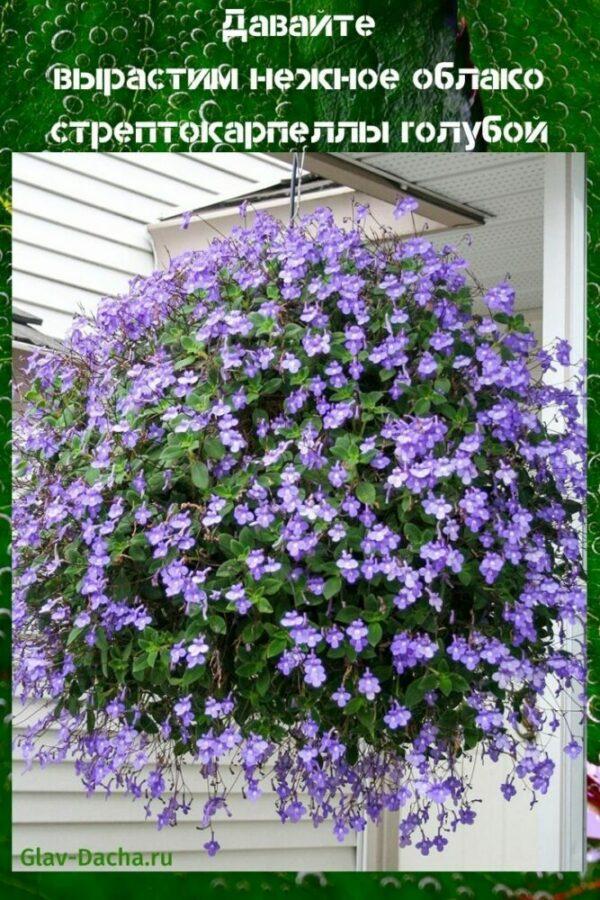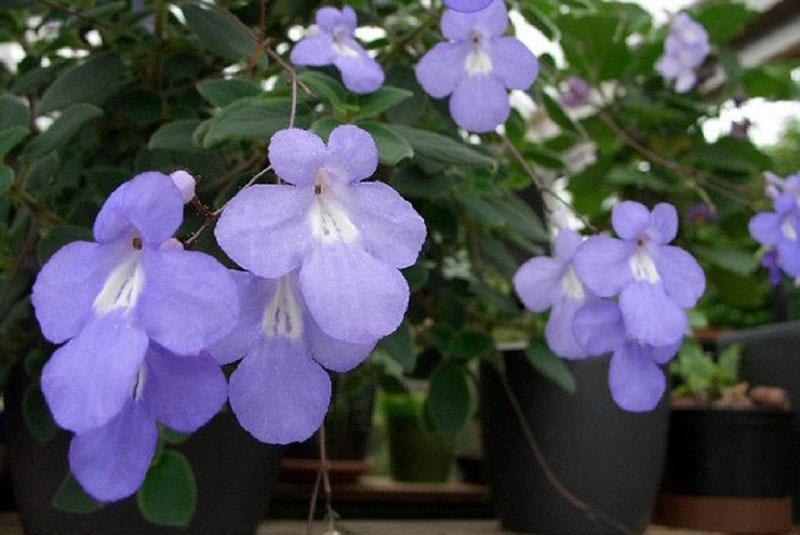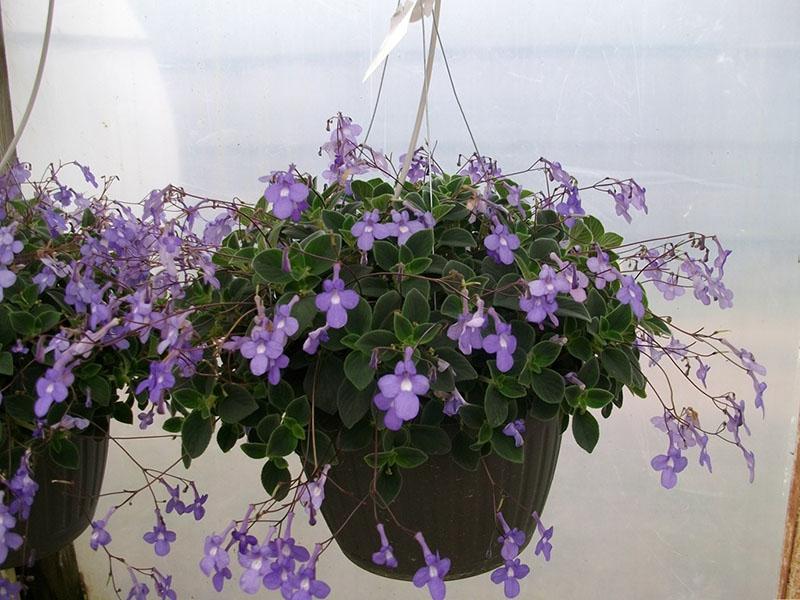Let's grow a gentle cloud of streptocarpella blue
 Streptocarpella blue is a delicate decorative flower that can be successfully grown in a private house or apartment. Its seeds were imported from South Africa. The plant is perennial, even in a non-flowering state it has high decorative qualities. And when it blooms, it attracts admiring eyes.
Streptocarpella blue is a delicate decorative flower that can be successfully grown in a private house or apartment. Its seeds were imported from South Africa. The plant is perennial, even in a non-flowering state it has high decorative qualities. And when it blooms, it attracts admiring eyes.
What does streptocarpella blue look like?

 Streptocarpella ampelous is used for space zoning. Designers love it for its amazing properties to add coziness to the atmosphere, expand the area with low ceilings, and zone the space. It is a striking accent that adds grace to the room.
Streptocarpella ampelous is used for space zoning. Designers love it for its amazing properties to add coziness to the atmosphere, expand the area with low ceilings, and zone the space. It is a striking accent that adds grace to the room.
In the warm season, streptocarpella blue can be successfully grown on a balcony, veranda or terrace.
Plant advantages and disadvantages
 The flower is picky about growing conditions. In order for streptocarpella blue to bloom profusely, the correct temperature regime, suitable lighting, and sufficient air humidity are necessary. The size of the pot and the composition of the soil matter. A lot of effort will have to be made, but proper home care for streptocarpella blue will be generously rewarded with abundant long flowering
The flower is picky about growing conditions. In order for streptocarpella blue to bloom profusely, the correct temperature regime, suitable lighting, and sufficient air humidity are necessary. The size of the pot and the composition of the soil matter. A lot of effort will have to be made, but proper home care for streptocarpella blue will be generously rewarded with abundant long flowering
An inexperienced grower can harm the plant by untimely pinching the shoots. If you do this too early, streptocarpella will not bloom in 3 months, but much later.
 The rest of the plant is unpretentious: it tolerates shade well, has a high ability to regenerate and reproduce, the rest period is very short. With careful attention, the plant does not infect infections and pests.
The rest of the plant is unpretentious: it tolerates shade well, has a high ability to regenerate and reproduce, the rest period is very short. With careful attention, the plant does not infect infections and pests.
Streptocarpella should not be placed in direct sunlight. It is better to choose a place with diffused light - the west and east windows are perfect. If the windows face south, it is better to place the plant away from the rays of the sun, a shelf on the wall or a niche in furniture will do.
Potting soil for streptocarpella blue is necessary:
- Loose, nutritious, well-drained, the roots of the plant need air.
- The acidity is neutral.
- The ideal composition is black soil, sand and peat in equal proportions with the addition of a small amount of vermiculite and charcoal.
- If you use ready-made soil, the one that is intended for growing Saintpaulia and Gloxinia is suitable.
Features of planting and transplanting streptocarpella blue
 Experienced gardeners can immediately plant cuttings in the ground by covering them with a jar. An improvised greenhouse with a streptocarpella sprout must be installed in a well-lit warm place and ventilated daily. After the appearance of new seedlings, the jar can be removed.
Experienced gardeners can immediately plant cuttings in the ground by covering them with a jar. An improvised greenhouse with a streptocarpella sprout must be installed in a well-lit warm place and ventilated daily. After the appearance of new seedlings, the jar can be removed.
You can transplant streptocarpella at any time of the year; it needs to change the soil annually.
 has a shallow root system, so it needs a shallow pot. More drainage is laid at the bottom. It is better to grow no more than one plant in each pot so that the bushes bloom magnificently and do not clog each other.
has a shallow root system, so it needs a shallow pot. More drainage is laid at the bottom. It is better to grow no more than one plant in each pot so that the bushes bloom magnificently and do not clog each other.
After 5-7 years, the leaves of the plant become lignified, so streptocarpella loses its attractiveness. It needs to be completely renewed.
Irrigation and temperature regime
 Since the roots of Streptocarpella blue are close to the surface, the plant needs frequent, moderate irrigation. As soon as the top layer of the soil has dried, it must be moistened. Drying out will lead to curling of the leaves, and waterlogging will lead to decay of the roots. Excess moisture from the pallet must be drained.
Since the roots of Streptocarpella blue are close to the surface, the plant needs frequent, moderate irrigation. As soon as the top layer of the soil has dried, it must be moistened. Drying out will lead to curling of the leaves, and waterlogging will lead to decay of the roots. Excess moisture from the pallet must be drained.
It is advisable that water does not fall on the fleecy leaves, this can provoke the occurrence of rot.
 For the proper development of the bush, moist air is needed. Therefore, it is recommended to install a tray with wet pebbles near the flower, moss or expanded clay. Household humidifiers are also suitable. Under natural conditions, streptocarpella grows in the tropics, so the ideal climate for it should correspond to the usual conditions.
For the proper development of the bush, moist air is needed. Therefore, it is recommended to install a tray with wet pebbles near the flower, moss or expanded clay. Household humidifiers are also suitable. Under natural conditions, streptocarpella grows in the tropics, so the ideal climate for it should correspond to the usual conditions.
Home care for streptocarpella blue implies compliance with the temperature regime. The plant will actively develop at a temperature of 20-25 ºС. When the temperature drops to +18 ºС, streptocarpella blue stops flowering and prepares for dormancy.
Fertilization is recommended every 2 weeks. You can use a ready-made composition for plants of the Gesneriev family or use any complex for indoor flowers.
Moderation is important, too frequent and plentiful feeding will harm blue streptocarpella. Therefore, even the dose recommended by the fertilizer manufacturer is best divided in half.
How to make streptocarpella blue bloom
 The flowering of streptocarpella blue can be made continuous, for this it must be under diffused lighting for at least 14 hours a day. In autumn and winter, the plant is necessary additionally illuminate with phytolamps.
The flowering of streptocarpella blue can be made continuous, for this it must be under diffused lighting for at least 14 hours a day. In autumn and winter, the plant is necessary additionally illuminate with phytolamps.
If the flowering cannot be made year-round, after the flowering of the streptocarpella is completed, you need to give it a couple of months to rest - reduce watering and feeding, move the pot to a darker and cooler place. Such procedures will have a beneficial effect on the condition of the flower, it will gain strength and soon will actively bloom and multiply again.
The stems of streptocarpella can grow in a chaotic manner, the appearance of such a plant will not be very beautiful, so it is recommended to regularly pinch the shoots. This prevents excessive tillering, promotes airing of the crown, and prevents the onset and development of infections. Withered peduncles must be removed.
How strepcarpella blue reproduces
 Streptocarpella blue in natural conditions propagates by seeds, but this method is not suitable for home cultivation. Florists prefer to cut apical petioles with 2-3 leaves from an adult plant, root them and plant them in the ground. This reproduction of streptocarpella is considered the easiest and most effective.
Streptocarpella blue in natural conditions propagates by seeds, but this method is not suitable for home cultivation. Florists prefer to cut apical petioles with 2-3 leaves from an adult plant, root them and plant them in the ground. This reproduction of streptocarpella is considered the easiest and most effective.
Violation of the conditions of detention can provoke the occurrence of diseases in the flower. Streptocarpella blue can be infected by viruses, insects. It is recommended to periodically spray the soil with arcacids and fungicides, to prevent drafts, a sharp drop in air temperature and waterlogging of the soil. Care rules must be strictly observed, then the blue streptocarpella will delight with abundant flowering and juicy emerald greens.